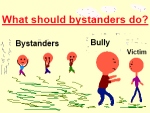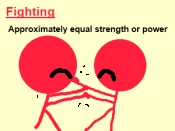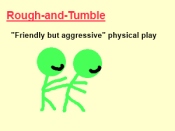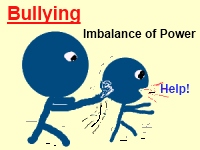
Bullying: Stop Bullying
--Bystander Intervention


www.EducationDx.com

Most people don't like bullying and don't like to see or hear about others being bullied. Then why don't people who witness bullying taking place at school (or other places) discourage it? School personnel are not usually present to take any action and may not be told about it, until later--if at all. Bullying can take place on the way to school, after school on the way home or at some other time.
So does that make the others who do observe the behavior responsible to stop it? You would think so. But some students do not choose to help the victim when s/he is being bullied. In fact, some students who observe bullying are much more likely to encourage or assist the bully rather than trying to help the victim!
So does that make the others who do observe the behavior responsible to stop it? You would think so. But some students do not choose to help the victim when s/he is being bullied. In fact, some students who observe bullying are much more likely to encourage or assist the bully rather than trying to help the victim!
Other pages of interest:


Just telling children to stand up for others isn't enough. They have to know what to do. For example, sometimes telling the bully to stop might work, but in other instances, just escorting the victim to a safe area might be the right thing to do. Practice and role-playing may help students to critically think what to do and what not to do.
Some studies observe that when bystanders intervene, the bullying stops within a few seconds in over half of the cases. Also, bystanders can stop relational aggression (name calling and gossiping) by not participating or simply stating that "this isn't right."
Not sure? Ask an adult (parents, teacher, guidance counselor, principal) what to do!
Some studies observe that when bystanders intervene, the bullying stops within a few seconds in over half of the cases. Also, bystanders can stop relational aggression (name calling and gossiping) by not participating or simply stating that "this isn't right."
Not sure? Ask an adult (parents, teacher, guidance counselor, principal) what to do!

Effective Bystander Intervention Programs
Most bully prevention/intervention programs include some common criteria
:
*Create a caring school climate (respect and personal responsibility)
*Parental involvement (in all stages)
*Train all school personnel (this includes all staff-secretaries, cafeteria workers, ...)
*Teach students about bullying/tattling-reporting
*Recruit student leaders in developing the program
*Empower bystanders (teach positive behavior and critical-thinking skills)
*Conduct schoolwide bullying prevention activities
*Conduct classroom bullying prevention activities
*Have schoolwide anti-bullying rules
*Parental involvement (in all stages)
*Train all school personnel (this includes all staff-secretaries, cafeteria workers, ...)
*Teach students about bullying/tattling-reporting
*Recruit student leaders in developing the program
*Empower bystanders (teach positive behavior and critical-thinking skills)
*Conduct schoolwide bullying prevention activities
*Conduct classroom bullying prevention activities
*Have schoolwide anti-bullying rules


Bystanders should do what they can do safely, and sometimes that means calling an adult to intervene or help! Also, the behavior distinguishing actual physical fighting (with intent to physically hurt), rough-and-tumble (aggressive "friendly" physical play), and bullying can be blurry at times. Sometimes bullying or rough-and-tumble play can develop into a real fight.
One main difference between real fighting and bullying (which can include a real, but usually uneven [power] fight) concerns the repeated nature of the behavior and the balance of power. Real fighting is often a one-time event between two parties of reasonably equal strength or power.
One main difference between real fighting and bullying (which can include a real, but usually uneven [power] fight) concerns the repeated nature of the behavior and the balance of power. Real fighting is often a one-time event between two parties of reasonably equal strength or power.

Children should not be encouraged to intervene physically
in a fight or any dangerous situation.
in a fight or any dangerous situation.




There are different reasons why this may occur, like the bystander fears getting hurt, s/he "likes" the bully, doesn't want the bully's attention/wrath, or maybe doesn't like the victim enough to care. Sometimes, the bystander just doesn't know what to do.





■
What is Bullying?
■
Bullying Quick Notes
■
Dealing with Bullying
■
Cyberbullying
■
Bystander Intervention
Bystanders-those who watch bullying happen or hear about it.

EducationDx
is a
FREE
Website
is a
FREE
Website
Bullying: In the Schools
If a school institutes a bully prevention/intervention program (and actually practices it and has everyone trained and involved) the bystanders will all know what to do. Everybody in the school (including the bully) is aware that bullying hurts the entire school and that everybody has a responsibility to help prevent it.
Students learn that when they witness bullying, they should not encourage the bully or join in the bullying. Also, bystanders who cheer on or help the bully are just as responsible for the bullying as the bully himself/herself. If by encouraging the bully works to make him/her become more aggressive, the bystanders can use this same power to discourage the bullying behavior.
Students learn that when they witness bullying, they should not encourage the bully or join in the bullying. Also, bystanders who cheer on or help the bully are just as responsible for the bullying as the bully himself/herself. If by encouraging the bully works to make him/her become more aggressive, the bystanders can use this same power to discourage the bullying behavior.


Bystander Intervention
This is a FREE information site!

www.EducationDx.com
Note: Larger computer screens will show larger materials!
Bullying: Stop Bullying--Bystander Intervention
Bystanders-those who watch bullying happen or hear about it.
Most people don't like bullying and don't like to see or hear about others being bullied. Then why don't people who witness bullying taking place at school (or other places) discourage it? School personnel are not usually present to take any action and may not be told about it, until later--if at all. Bullying can take place on the way to school, after school on the way home or at some other time.
So does that make the others who do observe the behavior responsible to stop it? You would think so. But some students do not choose to help the victim when s/he is being bullied. In fact, some students who observe bullying are much more likely to encourage or assist the bully rather than trying to help the victim!
So does that make the others who do observe the behavior responsible to stop it? You would think so. But some students do not choose to help the victim when s/he is being bullied. In fact, some students who observe bullying are much more likely to encourage or assist the bully rather than trying to help the victim!

There are different reasons why this may occur, like the bystander fears getting hurt, s/he "likes" the bully, doesn't want the bully's attention/wrath, or maybe doesn't like the victim enough to care. Sometimes, the bystander just doesn't know what to do.

If a school institutes a bully prevention/intervention program (and actually practices it and has everyone trained and involved) the bystanders will all know what to do. Everybody in the school (including the bully) is aware that bullying hurts the entire school and that everybody has a responsibility to help prevent it.
Students learn that when they witness bullying, they should not encourage the bully or join in the bullying. Also, bystanders who cheer on or help the bully are just as responsible for the bullying as the bully himself/herself. If by encouraging the bully works to make him/her become more aggressive, the bystanders can use this same power to discourage the bullying behavior.
Students learn that when they witness bullying, they should not encourage the bully or join in the bullying. Also, bystanders who cheer on or help the bully are just as responsible for the bullying as the bully himself/herself. If by encouraging the bully works to make him/her become more aggressive, the bystanders can use this same power to discourage the bullying behavior.


Just telling children to stand up for others isn't enough. They have to know what to do. For example, sometimes telling the bully to stop might work, but in other instances, just escorting the victim to a safe area might be the right thing to do. Practice and role-playing may help students to critically think what to do and what not to do.
Some studies observe that when bystanders intervene, the bullying stops within a few seconds in over half of the cases. Also, bystanders can stop relational aggression (name calling and gossiping) by not participating or simply stating that "this isn't right."
Not sure? Ask an adult (parents, teacher, guidance counselor, principal) what to do!
Some studies observe that when bystanders intervene, the bullying stops within a few seconds in over half of the cases. Also, bystanders can stop relational aggression (name calling and gossiping) by not participating or simply stating that "this isn't right."
Not sure? Ask an adult (parents, teacher, guidance counselor, principal) what to do!


Effective Bystander Intervention Programs
Most bully prevention/intervention programs include some common criteria:
Most bully prevention/intervention programs include some common criteria:
*Create a caring school climate (respect and personal responsibility)
*Parental involvement (in all stages)
*Train all school personnel (this includes all staff-secretaries, cafeteria workers, ...)
*Teach students about bullying/tattling-reporting
*Recruit student leaders in developing the program
*Empower bystanders (teach positive behavior and critical-thinking skills)
*Conduct schoolwide bullying prevention activities
*Conduct classroom bullying prevention activities
*Have schoolwide anti-bullying rules
*Parental involvement (in all stages)
*Train all school personnel (this includes all staff-secretaries, cafeteria workers, ...)
*Teach students about bullying/tattling-reporting
*Recruit student leaders in developing the program
*Empower bystanders (teach positive behavior and critical-thinking skills)
*Conduct schoolwide bullying prevention activities
*Conduct classroom bullying prevention activities
*Have schoolwide anti-bullying rules

Children should not be encouraged to intervene physically in a fight or any dangerous situation.

Bystanders should do what they can do safely, and sometimes that means calling an adult to intervene or help. Also, the behavior distinguishing actual physical fighting (with intent to physically hurt), rough-and-tumble (aggressive "friendly" physical play), and bullying can be blurry at times. Sometimes bullying or rough-and-tumble play can develop into a real fight.
One main difference between real fighting and bullying (which can include a real, but usually uneven [power] fight) concerns the repeated nature of the behavior and the balance of power. Real fighting is often a one-time event between two parties of reasonably equal strength or power.
One main difference between real fighting and bullying (which can include a real, but usually uneven [power] fight) concerns the repeated nature of the behavior and the balance of power. Real fighting is often a one-time event between two parties of reasonably equal strength or power.







Help
Bullying
Disclosure:
Some links on this website are associate links and are used to help illustrate what an item looks like, and you can decide if you want to just look or purchase the item. "As an Amazon Associate, I earn from qualifying purchases." We receive a small commission (that helps support this website) if you actually purchase from this company, but the price to you remains the same.
You can hover over any link to see if it is an Amazon link, if this matters, or a link to a page on this website or to a reference page, e.g., Smithsonian Institution, bookmark on this website, etc.
Some links on this website are associate links and are used to help illustrate what an item looks like, and you can decide if you want to just look or purchase the item. "As an Amazon Associate, I earn from qualifying purchases." We receive a small commission (that helps support this website) if you actually purchase from this company, but the price to you remains the same.
You can hover over any link to see if it is an Amazon link, if this matters, or a link to a page on this website or to a reference page, e.g., Smithsonian Institution, bookmark on this website, etc.
EducationDx
©2015, 2023
©2015, 2023


Amazon Links

Amazon Links

Disclosure:
Some links on this website are associate links and are used to help illustrate what an item looks like, and you can decide if you want to just look or purchase the item. "As an Amazon Associate, I earn from qualifying purchases." We receive a small commission (that helps support this website) if you actually purchase from this company, but the price to you remains the same.
You can hover over any link to see if it is an Amazon link, if this matters, or a link to a page on this website or to a reference page, e.g., Smithsonian Institution, bookmark on this website, etc.
Some links on this website are associate links and are used to help illustrate what an item looks like, and you can decide if you want to just look or purchase the item. "As an Amazon Associate, I earn from qualifying purchases." We receive a small commission (that helps support this website) if you actually purchase from this company, but the price to you remains the same.
You can hover over any link to see if it is an Amazon link, if this matters, or a link to a page on this website or to a reference page, e.g., Smithsonian Institution, bookmark on this website, etc.

EducationDx
©2015, 2023
©2015, 2023